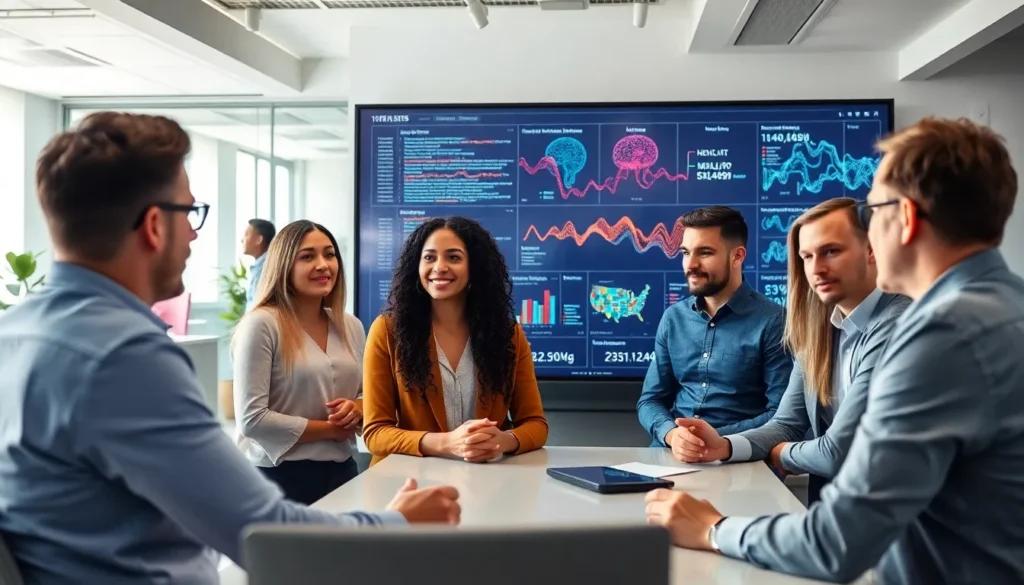Table of Contents
ToggleDeep learning has transformed the landscape of technology, powering innovations that were once considered science fiction. From voice assistants to self-driving cars, its applications are reshaping industries and enhancing everyday life. This powerful subset of artificial intelligence mimics the human brain’s neural networks, enabling machines to learn and make decisions with remarkable accuracy.
As businesses and researchers continue to explore its potential, deep learning is making significant strides in fields like healthcare, finance, and entertainment. By harnessing vast amounts of data, it uncovers patterns and insights that drive smarter solutions. Understanding these applications not only highlights the technology’s impact but also sparks curiosity about its future possibilities.
Overview of Deep Learning Applications
Deep learning applications demonstrate transformative capabilities across various sectors, enhancing performance and efficiency. The use of neural networks, especially deep convolutional networks, allows systems to process complex data like images, sounds, and texts.
Healthcare
Deep learning significantly advances healthcare technology. Algorithms analyze medical images, improving diagnosis accuracy by detecting conditions such as tumors or fractures. For instance, systems like Google’s DeepMind showcase remarkable proficiency in identifying eye diseases from scans.
Finance
Deep learning enhances financial services by optimizing trading strategies and fraud detection. Models analyze vast transaction datasets, identifying patterns indicative of fraudulent activity. For example, JP Morgan utilizes deep learning to streamline risk assessment processes, reducing errors and improving decision-making.
Entertainment
Deep learning transforms content creation and recommendation systems in entertainment. Streaming services, like Netflix, employ algorithms to analyze user preferences, tailoring recommendations. Additionally, deep learning generates realistic audio and video content, contributing to advancements in virtual reality.
Automotive
Deep learning is pivotal in developing autonomous vehicle technology. Algorithms process inputs from cameras and sensors, enabling vehicles to navigate safely. Companies like Tesla utilize deep learning to improve their self-driving capabilities, enhancing road safety through real-time data analysis.
Natural Language Processing
Deep learning revolutionizes natural language processing (NLP), facilitating accurate language translation and sentiment analysis. Applications like Google Translate leverage neural networks to provide seamless translations across multiple languages, enhancing global communication.
Robotics
Deep learning empowers robotics, enabling machines to learn from environments and adapt to changes. Robots equipped with deep learning algorithms excel in tasks such as object recognition and manipulation, increasing efficiency in manufacturing and logistics.
These applications exemplify deep learning’s substantial impact, providing innovative solutions that reshape industries and improve user experiences.
Healthcare Innovations

Deep learning drives remarkable advancements in healthcare by enhancing diagnosis, treatment, and patient management. It leverages vast datasets to produce insights that significantly improve patient outcomes.
Medical Imaging Techniques
Medical imaging enhances diagnostic accuracy through deep learning algorithms that analyze images from X-rays, MRIs, and CT scans. Technologies developed by companies like Google DeepMind can detect conditions such as diabetic retinopathy and cancer with accuracy surpassing human radiologists. These algorithms utilize convolutional neural networks (CNNs) to identify subtle patterns in images, leading to earlier and more precise diagnoses. Institutions like Stanford University’s School of Medicine have demonstrated these capabilities, contributing to timely and effective patient care.
Predictive Analytics in Patient Care
Predictive analytics in patient care employs deep learning to forecast patient outcomes and personalize treatment plans. Algorithms analyze historical patient data, lab results, and symptoms to predict disease progression. For example, healthcare systems leverage deep learning to identify patients at high risk for readmission or complications, enabling proactive interventions. Organizations like Mount Sinai Health System utilize these models to optimize resource allocation and tailor therapies, thereby enhancing overall patient management and reducing healthcare costs.
Financial Services Enhancements
Deep learning significantly enhances the financial services sector by improving fraud detection and enabling algorithmic trading. These advancements lead to increased efficiency, accuracy, and security in financial operations.
Fraud Detection Systems
Fraud detection systems leverage deep learning algorithms to analyze transaction patterns and identify suspicious activities. Models trained on historical data detect anomalies in real-time, reducing false positives and enhancing security measures for financial institutions. Companies like PayPal utilize deep learning techniques to strengthen their detection capabilities, preventing fraudulent transactions and safeguarding customer information. Research indicates that deep learning systems can reduce fraud by up to 80%, substantially minimizing financial losses.
Algorithmic Trading Solutions
Algorithmic trading solutions benefit from deep learning by analyzing vast amounts of market data to inform trading decisions. These models utilize historical trends, economic indicators, and social media sentiment to predict price movements with high precision. Firms like Goldman Sachs employ deep learning to enhance trading strategies, improving returns on investment. Studies show that integrating deep learning into trading algorithms increases profitability by approximately 5-15% compared to traditional methods, revolutionizing market engagement.
Autonomous Systems
Autonomous systems rapidly evolve, leveraging deep learning to enhance efficiency and accuracy. This technology drives advancements in self-driving cars, drones, and robots, enabling safer and smarter operations.
Self-Driving Cars
Self-driving cars utilize deep learning algorithms to navigate complex environments. These vehicles analyze real-time data from sensors, cameras, and LIDAR systems to interpret surroundings and make driving decisions. Companies like Tesla and Waymo deploy neural networks for object recognition, lane detection, and adaptive control, significantly improving safety. Research shows that autonomously driven vehicles could reduce traffic accidents by up to 90% due to precise calculations and constant vigilance. Furthermore, predictive capabilities allow for better route optimization, enhancing travel efficiency and reducing congestion in urban areas.
Drones and Robotics
Drones and robotics integrate deep learning to perform tasks with minimal human intervention. Drones equipped with deep learning models can autonomously navigate while avoiding obstacles and optimizing flight paths. Applications range from agricultural monitoring to search and rescue operations, with companies like Zipline demonstrating life-saving logistics through precision delivery systems.
Robotics benefits from deep learning by enabling machines to adapt to varied environments and improve task efficiency. For example, warehouse robots use advanced algorithms for spatial recognition, allowing them to locate and transport items accurately. Research indicates that integrating deep learning in robotic systems can enhance performance metrics by up to 30%, leading to faster production cycles and reduced operational costs.
Natural Language Processing
Natural Language Processing (NLP) represents a critical application of deep learning, allowing machines to understand and interpret human language. This capability transforms communication between humans and technology, enhancing user experiences across various platforms.
Chatbots and Virtual Assistants
Chatbots and virtual assistants utilize NLP to facilitate seamless interactions. Platforms like Apple’s Siri, Google Assistant, and Amazon’s Alexa leverage deep learning models to process and understand user queries. These systems analyze spoken or written language, interpreting context and intent. Enhanced accuracy improves customer service efficiency, with studies showing that chatbots can handle up to 70% of routine inquiries without human intervention. Furthermore, NLP enables these systems to learn from user interactions, continuously refining their responses to provide increasingly relevant information and assistance.
Sentiment Analysis Tools
Sentiment analysis tools apply NLP to assess opinions and emotions in user-generated content. Businesses use these tools to monitor social media, customer reviews, and surveys, helping gauge public perception of products or services. Deep learning algorithms analyze text for sentiment indicators, categorizing content as positive, negative, or neutral. Research highlights a 90% accuracy rate in sentiment detection when utilizing advanced deep learning techniques. By interpreting customer sentiment, organizations can adapt their strategies and address issues promptly, fostering stronger customer relationships and informed decision-making.
Deep learning is reshaping industries and driving innovation at an unprecedented pace. Its ability to analyze vast datasets and uncover insights is revolutionizing healthcare finance and entertainment. As organizations harness the power of deep learning technologies they’re not just improving efficiency but also enhancing accuracy and personalization in their services.
The ongoing advancements in autonomous systems and natural language processing highlight deep learning’s versatility and potential. With each breakthrough it becomes clear that this technology is not just a trend but a fundamental shift in how machines learn and interact with the world. The future holds even more promise as deep learning continues to evolve and integrate into everyday life.





